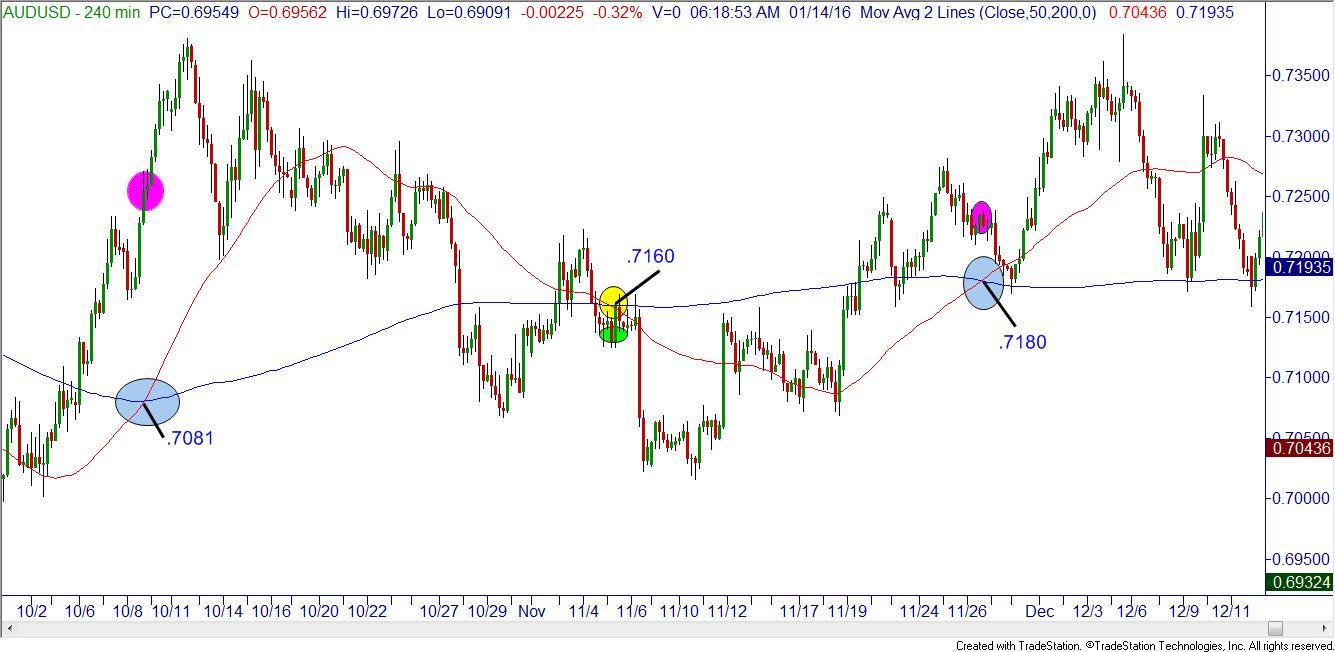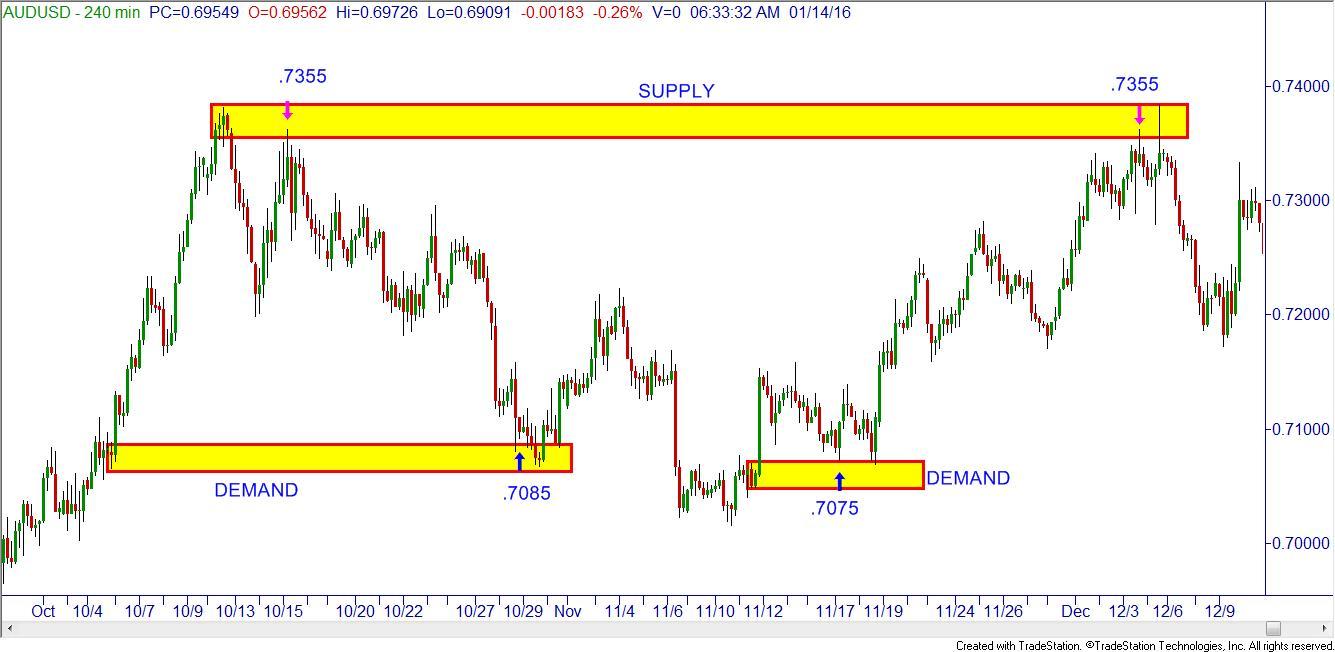![]()
Hello traders! Sooo…neither of us won the Powerball Jackpot of $1.5 billion dollars. Not that much of a surprise, is it? Knowing that the odds of winning were something like 1 in 292,000,000, we shouldn’t be shocked that we didn’t get the easy money. Now that the hype of the Powerball super- size jackpot has died down a bit, let’s discuss how we can increase the odds of success in trading, shall we?
Most people, when they first get into trading anything, end up reading a book about technical analysis or even perusing a few free websites trying to figure out how/when to enter and exit their trades. Very often they will use a set of “classic” technical indicators to make their decisions, such as a moving average crossover. In the following 240 minute AUDUSD chart, I’ve marked three moving averages crosses. Generally speaking, a new trader will buy when the faster moving average (in this case the 50 period) crosses upward through the slower moving average (the 200 in this example). This same trader will sell when the faster moving average crosses down through the slower. The “buy signals” are marked in blue, while the “sell signal” is marked in yellow.
Here is the huge problem. When looking at the chart, many new traders are looking at the price point where the moving averages CROSS, not where the price is when the moving averages cross. No, I’m not making this up. Having taught thousands of traders in my ten year tenure with Online Trading Academy, I’ve seen pretty much every mistake that exists in trading. (If you have a “new” mistake, one that hasn’t ever been done before, let me know!)
I’ve written on the chart what the prices of the crossovers were; the first buy in blue was .7081, the yellow sell was .7160, and the second blue buy was .7180. If you took these numbers as what you thought your entries were, you might have thought that you made about 80 pips on your first long trade (bought at .7081 and sold at .160). If you went short when you exited your long trade you would have lost only 20 pips (sold at .7160 and bought to cover at .7180) for a net gain of 60 pips. Not too bad, right? However, what were the prices of the actual CANDLES when the moving averages actually crossed? Uh oh, now we have a problem!
I’ve marked the actual prices on the chart as well. The first buy in the pink circle would have been at about .7250, the sell at .7135 (in the green circle), and the second buy at about .7230. Suddenly this technique looks terrible! So, the actual performance would have been a loss of about 115 pips on the first long trade; again, if you reversed your position when the moving averages crossed the short would have made a loss of about 95 pips! You can probably surmise what I think about moving average crossovers…
Here is another picture of the same pair and time frame, but instead I marked in a couple of demand zones and a supply zone. If you are new to Online Trading Academy, our core strategy tells us to buy in (what we believe is institutional) demand and to sell in (institutional) supply. Using our strategy, a short trade could have been taken at .7355 and covered at .7085-a gain of 270 pips. A long trade could have been taken at .7075, and exited at .7355, for a gain of 280 pips! A bit better performance, wouldn’t you say?
I want to mention one last tidbit to increase your odds in trading. Push back a bit from the screen you are reading this on. Now, notice how we have a relatively clear sideways channel over these couple of months of trading. Ever play the high-low game with a deck of cards, where you pull out a card and make a bet on if the next card will be higher or lower than the first? If you pull a 3, what are the odds that the next card will be higher than a 3? Pretty good, I would guess! If you pull a King, what are the odds that the next card will be lower than the King? Pretty good again! Now, if you pull a 9…now what? That’s pretty close to 50-50 odds that the next card could go either way. Using Online Trading Academy’s proprietary Odds Enhancers helps us to determine (figuratively speaking) what card we have pulled. Selling at the .7355 is like pulling a King…buying at the .7075 is like pulling a 3. Pretty high odds that the next card (trade!) will work out. To more fully understand how these Odds Enhancers can help you in your trading, see you in class!
This content is intended to provide educational information only. This information should not be construed as individual or customized legal, tax, financial or investment services. As each individual's situation is unique, a qualified professional should be consulted before making legal, tax, financial and investment decisions. The educational information provided in this article does not comprise any course or a part of any course that may be used as an educational credit for any certification purpose and will not prepare any User to be accredited for any licenses in any industry and will not prepare any User to get a job. Reproduced by permission from OTAcademy.com click here for Terms of Use: https://www.otacademy.com/about/terms
Editors’ Picks
EUR/USD edges lower toward 1.0700 post-US PCE

EUR/USD stays under modest bearish pressure but manages to hold above 1.0700 in the American session on Friday. The US Dollar (USD) gathers strength against its rivals after the stronger-than-forecast PCE inflation data, not allowing the pair to gain traction.
GBP/USD retreats to 1.2500 on renewed USD strength

GBP/USD lost its traction and turned negative on the day near 1.2500. Following the stronger-than-expected PCE inflation readings from the US, the USD stays resilient and makes it difficult for the pair to gather recovery momentum.
Gold struggles to hold above $2,350 following US inflation

Gold turned south and declined toward $2,340, erasing a large portion of its daily gains, as the USD benefited from PCE inflation data. The benchmark 10-year US yield, however, stays in negative territory and helps XAU/USD limit its losses.
Bitcoin Weekly Forecast: BTC’s next breakout could propel it to $80,000 Premium

Bitcoin’s recent price consolidation could be nearing its end as technical indicators and on-chain metrics suggest a potential upward breakout. However, this move would not be straightforward and could punish impatient investors.
Week ahead – Hawkish risk as Fed and NFP on tap, Eurozone data eyed too

Fed meets on Wednesday as US inflation stays elevated. Will Friday’s jobs report bring relief or more angst for the markets? Eurozone flash GDP and CPI numbers in focus for the Euro.
RECOMMENDED LESSONS
Making money in forex is easy if you know how the bankers trade!
Discover how to make money in forex is easy if you know how the bankers trade!
5 Forex News Events You Need To Know
In the fast moving world of currency markets, it is extremely important for new traders to know the list of important forex news...
Top 10 Chart Patterns Every Trader Should Know
Chart patterns are one of the most effective trading tools for a trader. They are pure price-action, and form on the basis of underlying buying and...
7 Ways to Avoid Forex Scams
The forex industry is recently seeing more and more scams. Here are 7 ways to avoid losing your money in such scams: Forex scams are becoming frequent. Michael Greenberg reports on luxurious expenses, including a submarine bought from the money taken from forex traders. Here’s another report of a forex fraud. So, how can we avoid falling in such forex scams?
What Are the 10 Fatal Mistakes Traders Make
Trading is exciting. Trading is hard. Trading is extremely hard. Some say that it takes more than 10,000 hours to master. Others believe that trading is the way to quick riches. They might be both wrong. What is important to know that no matter how experienced you are, mistakes will be part of the trading process.


